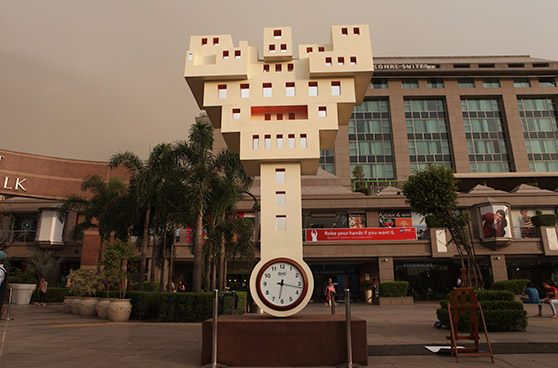An installation project at the Smart Museum Chicago.
Digital print, aluminum structure, fountain pump and water.
This installation has two sections combined together to make one elaborate sculptural and digital intervention. The digital part of the work is made out of photographic images of the city Delhi and manipulated in order to create an imaginary city scape which has it’s own complex cultural logic.
These images have been shot from the various part of the city keeping in mind the stark difference in the layers of social and economic classes that exist. It also closely looks into the character of a mega polis in a much more dissected manner. When an imaginary city is made based on real facts it generates a set of meanings, which in this particular case explores the irony and sarcasm of a social framework and it’s architectural/physical spaces.
The second part of the installation is a fountain, which stands in front of the digital wall. The fountain is made out of apartment blocks and largely appears as inspired by the general architectural look of the city on the wall. This fountain apartment deals with the scarcity and the abundance of water in the city. It poses the issues of drainage water, Dead Rivers and polluted water bodies around and in a city on one hand and the ignorance about the wastage of water by the public and private sectors on the other. When we observe the drastic changes and scarcity of the natural resources in the world we realize that the role of urbanization has its major contribution to this plight.
Fountains are the urban inventions to facilitate natural sources through the technical inputs. But in the present urban context with the polluted water bodies’ fountains have become the metaphors of a glorious past and a strong reminder of the troubles ahead. By placing a city and a fountain next to it creates a dialogue between man-made disaster and a natural calamity.
I have been engaged with the city of Delhi since last 16 years. Observing and engaging with Delhi on a permanent day today basis has formed much of my perception of urban spaces in India. The layers of social structures and hierarchies’ one encounters in a single day in Delhi leaves thought for the understanding of a much larger and wider notion called ‘India’. The urban and the rural, the class and cast, religion and practice and the endless list of eccentric and idiosyncratic exchanges of different social groups somehow create its own mystery in any urban space in India. For us ‘modernity’ is a big claim, which has to be approved and contextualized at every stage of any discourse. On the other hand an economically booming India stands with millions of middle class on its side, which constantly erase and redraw the map of India with a completely different set of tools and calculations. The repercussions and resonance of these new voices has also been woven into the urban fabric with variety of architectural and cultural forms. The new construction fever and mall culture could be a result of this phenomenon.
‘City unclaimed ‘ deals with the eccentricities nurtured and watered in a typical urban setting of India largely created and running through the migrant population and its constant ‘pilgrimage’. In its nature each part of the city claims its immediate vicinity but overall lies unattended and unclaimed by any system or logic. It grows and decays by its own logic, assigned by the mood of time and its everlasting nature of permanency if allowed to understand ‘time’ as the only phenomenon un- flickered and static.
Gigi Scaria
New Delhi 2012






















